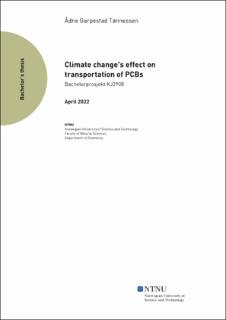Climate change's effect on transportation of PCBs
Bachelor thesis
Permanent lenke
https://hdl.handle.net/11250/2998746Utgivelsesdato
2022Metadata
Vis full innførselSamlinger
- Institutt for kjemi [1352]
Sammendrag
Studier indikerer at klima endringer og høyere temperaturer stimulerer transporten, oppdelingen og volatiliteten til polyklorerte bifenyler (PCBer). PCBer er vedvarende organiske forurensninger, som er giftige for miljøet. Det blir frigjort i miljøet, gjennom gammel elektrisk utstyr, maling og andre menneskeskapte kilder, og vil bli transportert via luften, havet og bioakkumulering i levende organismer. Long-range atmospheric transportation (LRAT) er hovedtransporteringsmetoden og den raskeste transporteringen, og er stimulert av økning i temperatur fra klimaendringene. LRAT er også påvirket av værsystemene og høyere vindhastigheter. Økningen i havtemperaturen og PCB eksponering, påvirker næringsnettet og opptaket av PCBer innenfor bioakkumuleringen. Økning i temperatur øker også mengden av den atmosfæriske vanndampen, som produserer mer OH radikaler. OH radikalene reagerer med PCBer og er hovedgrunnen til stoffets degradering i atmosfæren. En mulig økning av den totale mengden PCB i sirkulasjon i miljøet, vil også lede an til flere reaksjoner med ozon, som potensielt kan føre til skade på ozonlaget. Studies indicate that climate change and higher temperature stimulates the transportation, partitioning and volatility of polychlorinated biphenyls (PCBs). PCBs are a persistent organic pollutant, which is toxic for the environment. It gets released into the environment, through old electrical equipment, paint and other anthropogenic sources, and will then be transported via the air, ocean or bioaccumulation through living organisms. Long-range atmospheric transportation (LRAT) is the main source of transport and the fastest, and is stimulated by the increase in temperature due to the climate change. The LRAT is also affected by the weather systems and higher wind speeds. The increase in ocean temperature and PCB exposure, affects the food web and uptake of PCBs in bioaccumulation. Increase in temperature also increases the atmospheric water vapor, which produces more OH radicals. The OH radicals react with the PCBs, and are the main source to its degradation in the atmosphere. A possible increase in the total amount of PCBs in circulation in the environment, will also lead to more reactions with ozone, which could potentially damage the ozone layer.
